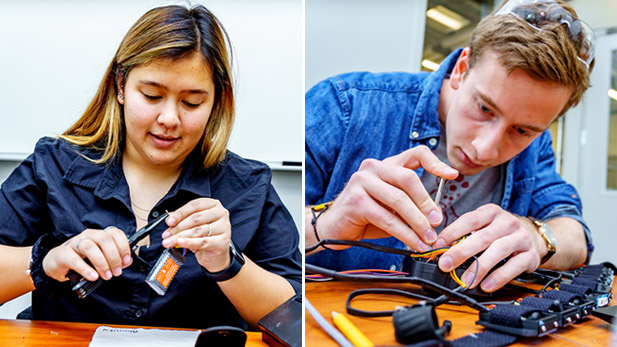Mechanical Engineering Students Design a Unique Electronic Travel Aid for the Visually Impaired

Mechanical Engineering students Alyssa Taylor and Joseph Lahmann set out to build an electronic travel aid for the visually impaired as part of their mechatronics class project.
Mechanical Engineering students Alyssa Taylor and Joseph Lahmann set out to build an electronic travel aid for the visually impaired as part of their mechatronics class project. What these students did not anticipate is they would create an innovative tool that would place them among six finalist teams in a highly competitive undergraduate design competition, which is part of the American Society of Mechanical Engineers’ Biomechanics BioTransport Bioengineering Conference. (Editor's note: They went on to place first at the June 22 competition).
Currently, most visually impaired individuals rely on external forces to help guide them safely, the most common include a site guide, dog or white cane. Lahmann and Taylor wanted to create a device for independence, something that is sorely lacking in the market. They also wanted it to be discreet and hands free.
“Every year I challenge students to think of creating devices that address local, regional and global needs,” says Assistant Professor of Mechanical Engineering Miles Canino, PhD. “Alyssa and Joseph came to me with the idea to make a travel aid that can communicate visual and spatial information to the visually impaired.”
What they created is a belt device a person wears around the abdomen, underneath clothing, and a lanyard worn around the neck. The lanyard contains two LiDAR scanning devices that continually rotate and scan up to eight feet and 30 frames per second around the person. When it senses an object and its proximity in front of the individual, it sends a signal to the ten motors contained in the belt. The belt then creates haptic feedback to a person’s midsection to indicate there is something in the person’s path. How close the object is to the person correlates to the intensity of the feeling and where they feel the sensation on their body.
Lahmann and Taylor created the electronic travel aid in ten weeks, an impressive amount of time considering it is not something that is currently on the medical device market. The few electronic travel aids that do exist for the visually impaired are hand-held devices. Those devices have a higher failure rate (because they are controlled by the human) and are expensive. The students are proud to have invented something that can truly make a difference in a person’s quality of life.
“A lot of the visually impaired feel singled out socially because they have to rely on something that makes them stand out, such as the cane or a dog,” says Taylor, who is a 2022 graduate. “That’s why we came up with the concept of it being discreet. Also, you lose the use of a hand with a dog, a person or a cane. With our device, they have the means to use both their hands.”
Both students admit this type of project that is helpful to people in real life is extremely rewarding.
“Working on something you care about is a really important factor,” says Lahmann, who is entering his senior year. “Dr. Canino has been extremely encouraging in that way.”
Canino, whose area of specialization is biomedical devices and rehabilitation robotics, served as the point of contact for the electrical and programming aspects of the device. He encouraged them to submit the device to the American Society of Mechanical Engineers’ Biomechanics BioTransport Bioengineering Conference’s undergraduate design competition. Lahmann and Taylor say they were shocked when they received the news they are among six finalists who will be presenting and demonstrating the project this summer to a podium of judges who are leaders in biomedical device engineering.